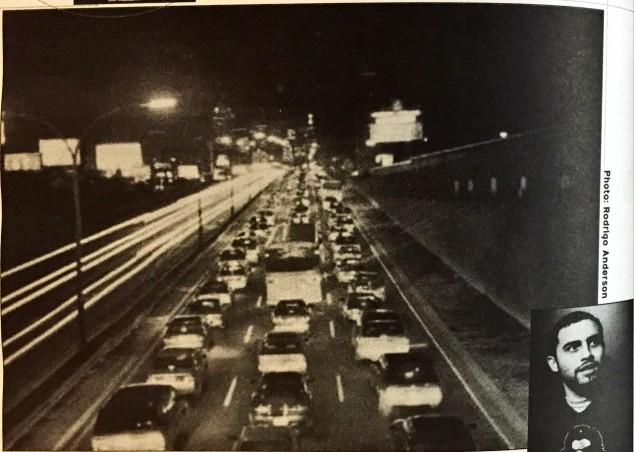Four people. Twenty-four words. Twenty-four hours. The RTA practicum group, Focal Shift Productions, play with photography, art, interpretation and time in their documentary, Exposure.
By Claudia De Simone
“Anyone can take pictures, but a photographer is an observer of life,” says screenwriter Joe Costa, 38, looking up at the ceiling for a moment, then continuing to sip from his two beers.
He was one of the four picture-takers bustling about Art System on Friday Feb. 8, checking out the photos he took for a radio and television arts practicum documentary, Exposure.
The fourth-year students who produced the 22-minute piece call their group Focal Shift Productions. The members are: Chloe Lewis, producer; Kevin Merchant, director of photography; Fred Vargas, story producer; and Lori Ward, associate producer. Their goal is to question whether a non-professional can create art, and let the viewers come to their own conclusions.
The seven-minute continuous-playing DVD and 96 pictures gave the 100 people in attendance a taste of the doc that is not yet edited.
With a list of the same 24 words, a manual camera and a time frame of 24 hours, each of the four photographers featured in the doc trekked around Toronto last fall to photograph images that represented each word.
A video camera and crew were behind them all the way. Focal Shift picked the first four people who agreed to be in the film — student Audrey Pagulayan, 18; hairstylist Rodrigo Anderson, 29; screenwriter Joe Costa, 38; and therapist Sherry Franz, 42. The group wanted people they didn’t know well or at all, who had no professional photography experience. Besides Anderson, Lewis’ hairdresser, and Costa, who worked with her, Franz and Pagulayan were friends of friends, whom the crew had not met prior to shooting the film.
“I thought this was a brilliant idea — giving people ideas (words) and letting them be free to formulate what the words mean to them,” says Costa.
They filmed one person per day, starting at 9 a.m., at Nathan Phillips Square.
“The people were really great and took it seriously,” says Lewis. “They had a lot of integrity and went the extra distance.”
Literally. From the Beaches, to High Park, to the CNE to Forest Hill, the photographers spanned the city, some having more distractions than others.
“I had to take breaks to see clients,” says Franz. She also had to get her cell phone repaired three times that day and go home to cook for her kids — after they tagged along with her all day. So the video crew worked around her schedule.
Her inspiration for the word sex came from her CD collection.
“To me, Tom Jones is sex,” she says pointing to a Tom Jones CD. “So, after I crossed it off the list, my son said, ‘Yeah, mom got sex!’ He meant the word.”
“We couldn’t influence their decisions. If they wanted to take three hours for lunch, then they did,” says Lewis.
Costa said he never felt limited. “The crew was like me: not pretentious, simple in their needs. I knew they were at my whim. It was a pretty symbiotic process.”
Instead of fitting words to a picture, Costa would do the opposite.
“Filmmaking made it more accessible me, since I think in pictures. It was easy for me to fit my pictures to the words,” he says.
Anderson, however, found the task overwhelming. He spent his days before the shoot thinking of words that could possibly be on the list.
“I was thinking, ‘what facade would best represent me?” he says. That’s why he crossed off his last word at 1 a.m.
In turn, Pagulayan says her creativity is based on her spontaneity.
“By looking around I have an idea of each person’s personality,” says Soheil Rashid, a professor of psychology of art and creativity at Ryerson.
Rashid noticed that a lot of the therapist’s photos involved people. Franz took a picture of her children eating dinner.
“Just because someone is a therapist doesn’t mean they can’t be an artist,” he says. “The question, ‘What is art?’ is completely unanswerable question.”
“Artistry is basically saying, ‘this is who I am.’ I don’t think of myself as definitive,” Costa says. “The picture I took that day symbolize my entire life.”
Focal Shift’s advisor, Liz Gesicki, think the group can take their project outside of the school. “I think the regular public will find it interesting,” she says.
Daniel Borins, founder of Art System, totally supported the experimental idea, so Focal Shift got the space for free.
“I was once interested in filmmaking and I know what a drag it is (to find a place to exhibit),” says Borins.
The editing process continues to make what used to be only an idea into a 22-minute documentary. Their intention is to edit the footage chronologically, so that the viewer understands what each person was photographing at a particular time of day.
The ideas will be flowing from the beginning to end, conveying the urgency of the project, as well as showing that a lot of space was covered, says Chloe.
Original electronic music samples, that Marchand put together, will play in the background, instead of narration. Sound bites of the photographers will be layered with visuals.











Leave a Reply